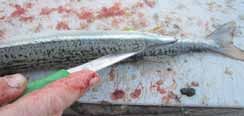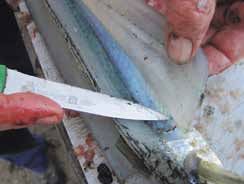Presented from Issue 100
Most of us have learned the various basic fish cleaning techniques passed down over the years. I am always on the lookout for faster and better methods and have picked up a few that I will describe in detail in this article. Once you have practised them I,m sure you will use some of these new methods in preference to your old ways.
Trout
Like many anglers I started catching and cleaning trout at an early age. There was only ever one way to clean them namely by slitting them up the gut through to the gills and then getting your hands in and cleaning out the rest. However on my first trip to New Zealand I purchased a New Zealand Trout book which featured the following method. It looks and is quite simple and I have used it to clean trout ever since. Apart from my immediate fishing companions I have never seen it used by other anglers.
|
Step 1 Hold the trout upside down and slit up the gut as you probably normally would however stop short of the gills by about 30mm, right between the pectoral fins. |
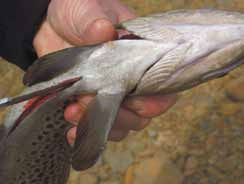 |
|
Step 2 Work your knife through the soft tissue under the trouts bottom jaw and cut through and up above the tongue. This is the final cut needed and you should now have a nice gap to place your left finger to hold onto the trout by the bottom jaw for the rest of the procedure. |
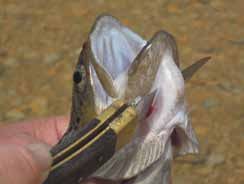 |
|
Step 3 This is the trickiest part so pay attention. By holding the trout as mentioned work your left thumb back down along either side of the cut made under the jaw. Slowly tear this cut through until the lower part of the jaw is fully opened up. Now place your left thumb deep into the guts and clasp the flesh around the gills and fins with your fingers. Push down slowly and roll your hand over as you go. The flesh around both fins will tear through and all the guts, gills and fins should pull out completely. Sometimes if you have cut to far up past the fins to start with the flesh here will simply pull through. This just means you now have to work each side separately to get both fins. |
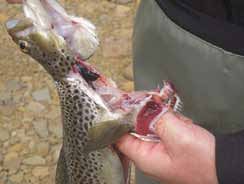 |
I have found with large fish over about 4 pound it is best to work each side separately and slowly as sometimes the neck of the trout will break and you no longer have anything to hold onto. The final product may appear a bit funny with the front two fins missing but who eats these. Trust me once you have mastered this method you will not revert to your old ways.
Couta
Certainly not a preferred sea fish for many people but its probably the long lateral bones that run through this fish that put people off. This method removes the flesh from a couta fillet which can later be made into fish cakes, a now staple diet in my family. All you need for this method is a bowl and large desert spoon.
Fillet the fish like any other and then lay the fillet skin side down. By holding onto and starting from the tail end slowly work the spoon up the length of the fillet. Because couta flesh is reasonable soft each run of the spoon will roll off some flesh which is simply placed into the bowl. Work all parts of the fillet thoroughly with the spoon. You should end up with a near fleshless piece of couta skin with all bones attached.
Flathead
Probably the most sort after and certainly one of the best eating fish easily caught in Tassie waters, but are we all sick of the rib cage bones. This method results in a skinless, boneless fillet. The following method will only work on fairly fresh fish as it involves some tearing of the flesh. Once the fish goes off even slightly the fillet will pull apart and half will be wasted.
|
Step 1 Fillet as you normally would by cutting down under the front fins to include as much meat as possible and fillet right down to the tail leaving the fillet just attached to the fish by a small piece of skin. Laying the fillet skin side down work the knife between the skin and flesh but stop just short of where the rib bones start |
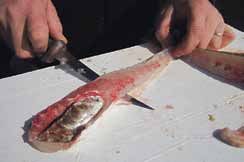 |
|
Step 2 Hold onto the skin of the fillet in one hand and with the aid of a wet rag grasp the flesh that has been filleted off and pull it slowly down and over the ribs. The meat should tear off around the bones leaving you with a Y shaped boneless fillet. |
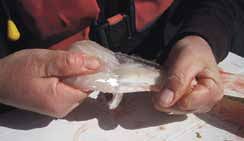 |
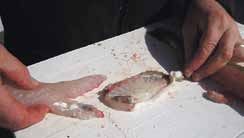 |
Garfish
When I first started targeting garfish I’m not sure whether they were harder to catch or clean. They certainly proved to be tricky little numbers but on our most recent trip to Georges Bay at St Helens everything came together and once located and kept in place with the berley trail we caught a decent feed. These fish are well worth the time and effort , they have to be one of the best eating fish we have. This brings us to cleaning methods of which I have now tried three but revert to the second method I was taught by an old master on Georges Bay namely the butterfly technique. The other two methods involved crushing a whole fish with a rolling pin or bottle and extracting the backbone from the tailend by cutting through and pulling it out. Don’t bother with either of these two methods, the first leaves small crushed bones, the second takes too long and a similar amount of meat is gained with the butterfly technique. A small razer sharp knife is essential for this technique as you only tend to use the extreme edge of the knife. The average size flathead style fillet knife will simply not cut it on these small fish.
|
Step 1 Prepare the garfish well by scaling them thoroughly. Half their scales will already be strewn around your boat as these things are second to squid for messy fish to catch. Starting near the tail fillet as you normally would and run the knife from the tail right up to behind the head just above the backbone. Expand the cut on the fillet by running the knife carefully along several times until the silver/blue belly sac is exposed. About two thirds of the fillet should be done. Repeat this process for the other side. |
|
|
Step 2 Hold the fish up and work the fillet down by slowly tearing the flesh under the front fins. Once you have enough fillet to grasp simply tear it right down to the tail from underneath. You should end up with a double fillet, joined underneath by the thin belly meat. It will be bone free and ready to cook. Cut up through the middle if you prefer to cook individual fillets . This method looks and sounds easy but takes a bit to master. The small sharp knife is the key, don’t start with anything less. When you have it down pat it takes about 45 seconds to do a fish |
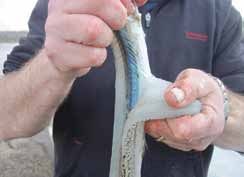 |
by Shane Flude

